

Structural foam molding is a type of manufacturing technique that has a unique approach and distinct advantages. It is a popular technique to create stronger, more rigid plastic parts and the means to reduce potential part weight for larger parts.
Today, structural foam molding is a highly evolved technique that can create lighter, stronger, and more resilient plastic parts than traditional injection molded parts. In this article, we discuss the structural foam molding technique in-depth, its design considerations, and key differences with traditional injection molding techniques.
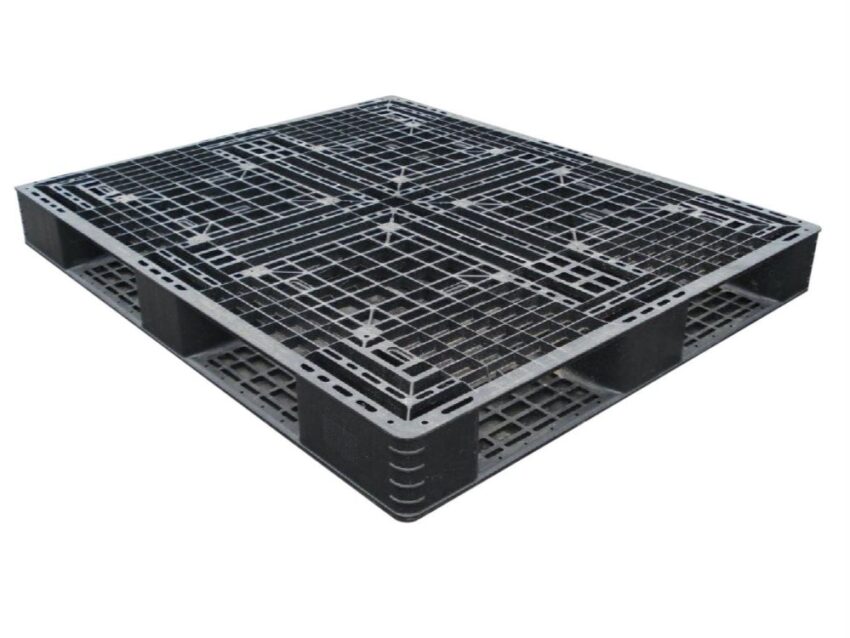
Structural foam molding is a type of manufacturing process in which, the packing stage involves mixing the molten resin with a blowing agent to create thermoplastic foam. The chemical blowing agent is subjected to heat and it works by creating a microcellular structure to expand the material and form the part against the mold.
As the cooling occurs, a honeycomb structure develops to form the interiors whereas a solid skin is formed against the mold. The honeycomb structure of the interiors has various advantages such as preventing shrinkage and reducing product weight without compromising structural integrity.
The process of structural foam molding primarily involves the addition of a blowing agent and the modification of process parameters to create a sandwich construction. This particular construction is solid on the outer layers and has a foam core center.
In the structural foam molding process, two components are stored in separate containers in liquid form which are then mixed to form a resin. This resin mix is injected into a pre-prepared mold which is then cured via chemical reaction. In this process, lesser quantities of the resin mix are used so that the resin itself does not fill the mold.
The blowing agent in this process is activated by the reaction between the two components and it further expands to fill the surplus space of the mold with foam which creates the honeycomb texture in the center. The surface cells collapse as they come in contact with the mold wall thereby creating a solid or rigid surface.
This is a low-pressure injection molding process and the intended aim is to reduce the density and thus, the weight of the finished part.
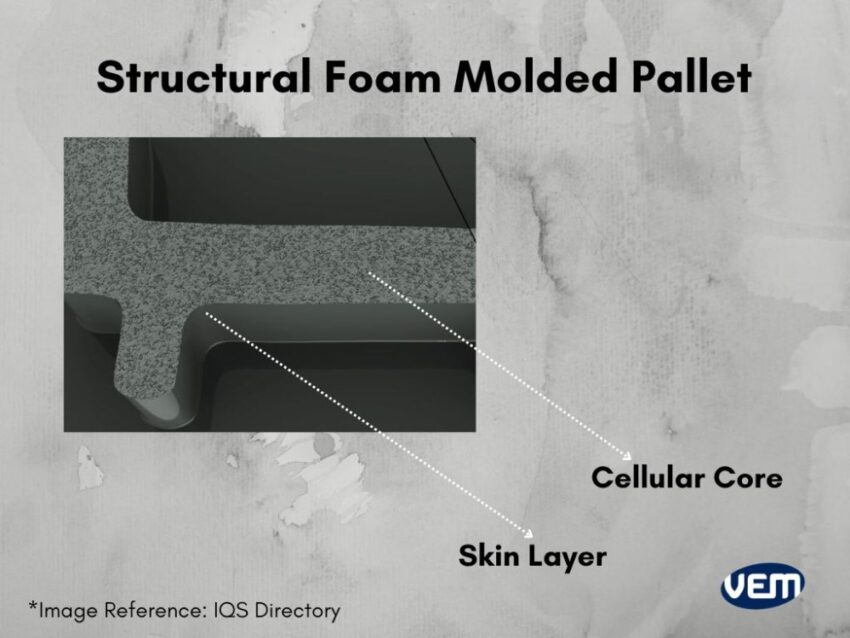
A structural foam is a type of composite material that is created when a polymer combines an inert physical gas, such as nitrogen, or a chemical blowing agent during the molding process. It has a low-density, cellular network at its core and is combined with a high-density solid skin. The cellular core decreases the overall weight while the solid surface enables the part to stay strong and impact resistant.
Since the base is a cellular network and not a solid structure, the base material that is typically used to create a structural foam is a thermoplastic polymer rather than a thermoset. Some of the most commonly used thermoplastics in structural foam molding are polyurethane, polycarbonate, polyphenylene oxide, and acrylonitrile butadiene styrene.
Just like any manufacturing technique, engineers must consider the design criteria early on in the process to manufacture parts efficiently via structural foam molding. Let’s understand the various design considerations for structural foam molding:
Draft angles are necessary design considerations in structural foam molding and since lower pressures are applied in this technique, the draft angles can be smaller. You should however; note that higher cavity pressures make it difficult to release the part from the mold which is why the draft angle should be larger if the wall thickness is thin.
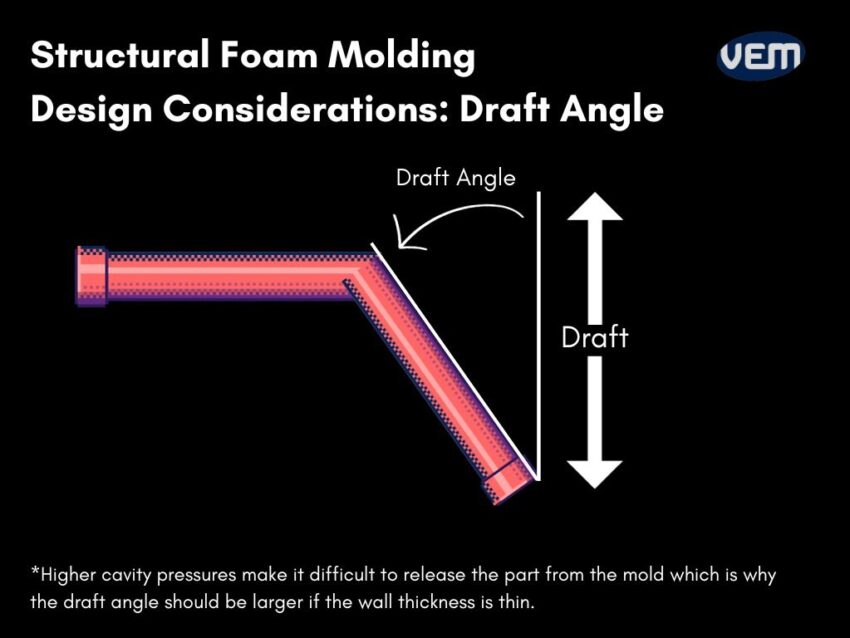
You should note that in structural foam molding, the part walls must be thicker as thin walls can deter the required reaction to create the cellular structure.
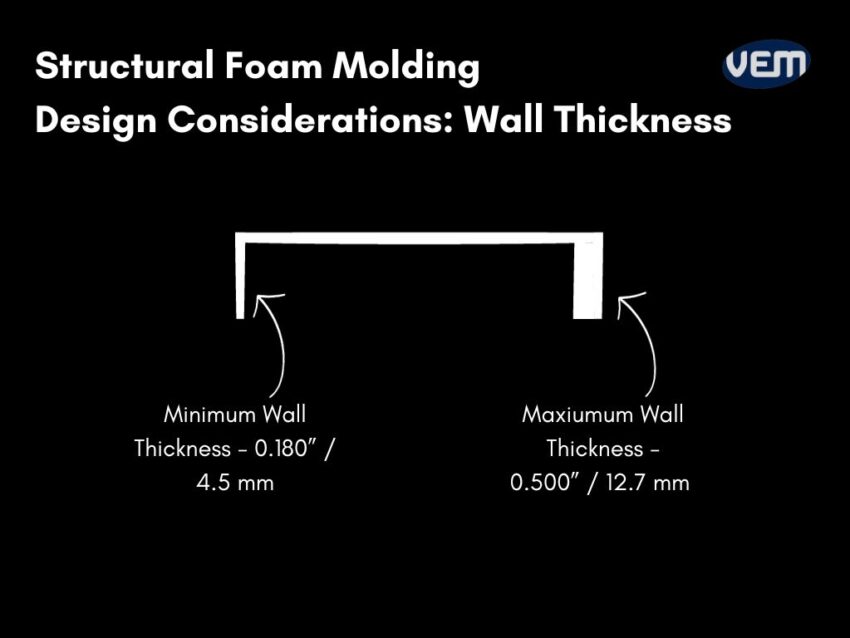
The wall thickness in structural foam molding can be as low as 0.180” / 4.5 mm, and up to 0.500” / 12.7 mm or thicker. The optimal thickness of wall sections should be 0.250” / 6.35 mm.
In structural foam molding, bosses are frequently used to insert and attach fasteners to assemble multiple structural foams, and ribs are commonly used to increase part rigidity and load-bearing capability. Ribs are also incorporated instead of increasing wall thickness.
You should note that molded-in bosses, mounting pads, and retainers can also be used in place of metal brackets.
If varying wall thicknesses are needed, then transitions from thick to thin should be tapered with radii and fillets. It is recommended to include a gate in the thinner section and let the material flow into the thicker sections.
You should note that there is a higher resistance in wall sections that are less than 0.250” / 6.35 mm however; this can be compensated with increased injection pressure.
Injection molding is carried out in two stages. The first stage is an injection stage, where the molten resin is injected into a mold, and the second stage is the packing stage, where pressure is built and the molten resin takes the mold shape to form the plastic part. In structural foam molding, the injection stage is similar to the traditional injection molding technique, however in the latter stage, the resin is mixed with a blowing agent that is activated by the molten resin’s heat. At this stage, the blowing agent expands the resin and creates a cellular foamed structure which takes the mold shape and forms the part.
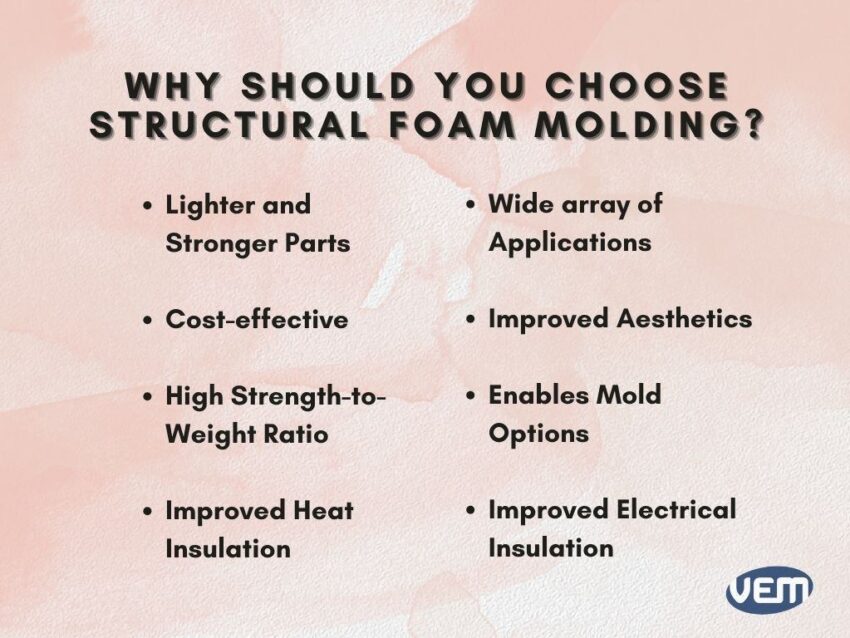
Traditional injection molding techniques are extremely expansive and inclusive to various project requirements however; structural foam molding techniques pose certain advantages w.r.t design and operational requirements. Let’s understand when should you choose structural foam molding over traditional injection molding techniques:
The parts manufactured via structural foam techniques aren’t as dense as similar parts that are manufactured using other processes and are thus lighter. The finished part manufactured via structural foam molding is typically 10 – 40% lighter than an equivalent solid part.
The honeycomb structure that is created during the structural foam molding process enables a very high strength-to-weight ratio as compared to the parts manufactured via traditional injection molding techniques.
The parts that are manufactured via the structural foam molding technique are much more impact-resistant and can be applied to manufacture large parts due to lower pressure and in metal-to-plastic replacement.
Parts manufactured via structural foam molding have a consistently polished surface.
Structural foam molding techniques can manufacture thick-walled parts and intricately detailed parts without causing any depressions or sink marks and it is thus more efficient than traditional injection molding techniques. In addition, the low-pressure injection process of structural molding reduces stress and plastic warpage issues.
You should note that although Aluminum molds are cost-effective, however; they aren’t long-lasting, especially when subjected to the high pressures of traditional injection molding techniques.
Structural foam molding is a low-pressure injection molding process which is why aluminum molds are suitable and can be used for this technique. In addition, structural foam injection molding can incorporate other types of materials such as metal and wood.
Structural foam molding is more economical than injection molding and other techniques. Since this technique can incorporate Aluminium molds instead of Steel molds, it gives the technique an edge in being cost-effective. The low pressure and clamping forces in this technique minimize the wear and tear. In addition, if Aluminum molds are maintained well, then their lifespan can be lengthened.
Structural foam molding is also a competitive technique in terms of cycle times when compared to injection molding and other techniques thus, making this technique a cost-effective as well as time-saving process.
Structural foam molding also allows greater flexibility in terms of resin selection since even commodity resins can be used in this technique, thus enabling manufacturers to lean towards cost-effective resins if possible.
The parts that are manufactured via structural foam molding have improved electrical insulation characteristics and better heat insulation as the cellular core of structural foam parts demonstrates excellent insulation properties, thus, making this technique apt for parts that require thermal or acoustic insulation.
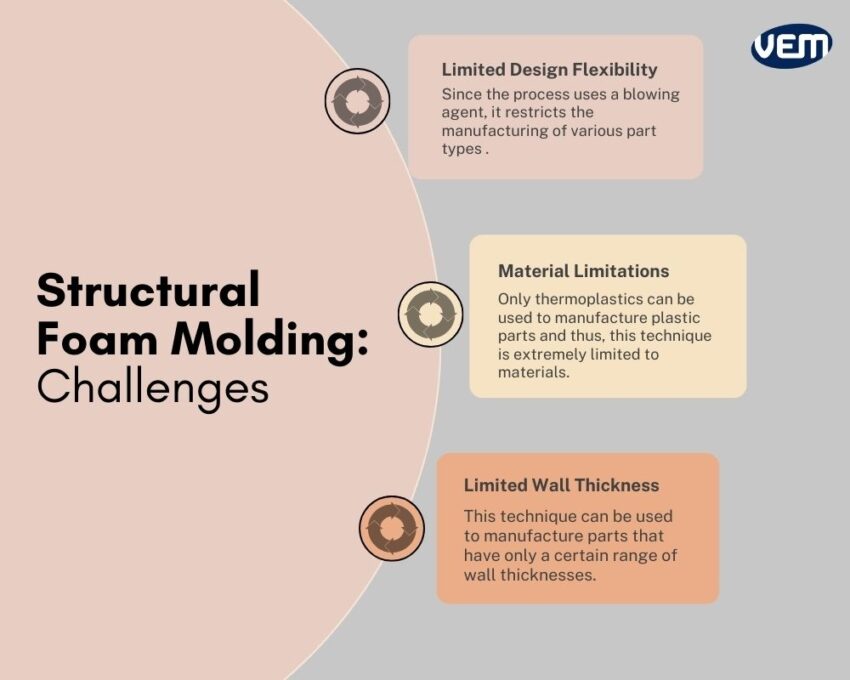
Since the structural foam molding process uses a blowing agent, it restricts the manufacturing of various part types and thus, has limited design flexibility.
Only thermoplastics can be used to manufacture plastic parts via the structural foam molding technique and thus, this technique is extremely limited to the type of materials that can be used for manufacturing.
This technique can be used to manufacture parts that have a certain range of wall thicknesses, and thus, is again limited to only certain types of parts.
Parts that are manufactured via the structural foam molding technique are lightweight, strong, and durable. Structural foam molding may be the right design choice if you’re seeking to manufacture a lower-weight high-strength part.
While we cannot do foam molding, you can still reach out to us to have a look at your part. In many assemblies, there are parts that can be manufactured by injection molding, which is our core competency for decades.
At VEM-Tooling, we have an experienced team of design experts and engineers who can help you choose the right solution for your project!